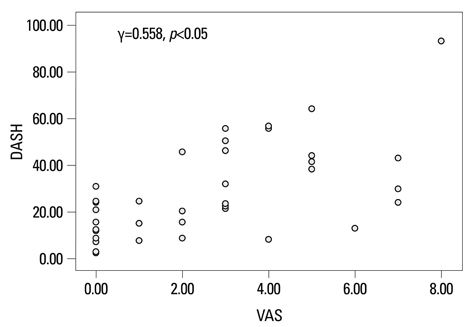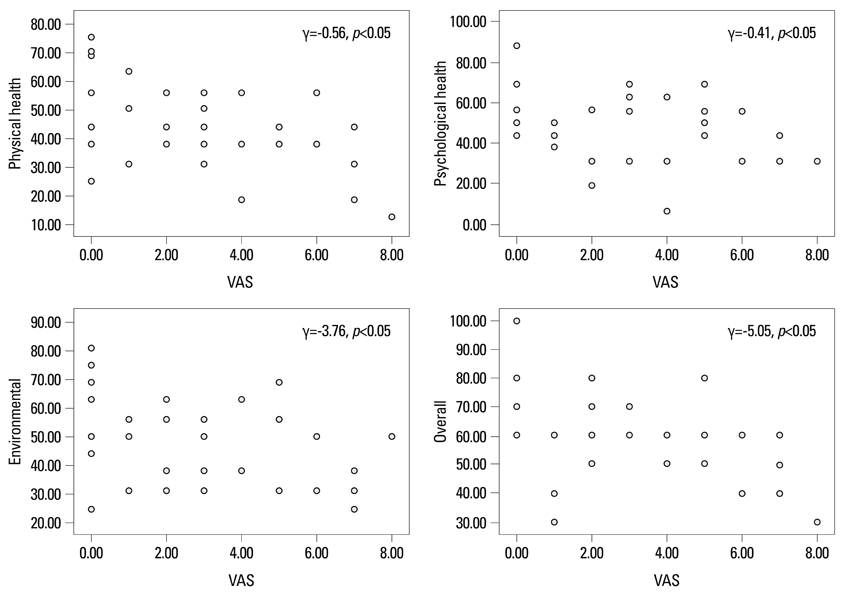Yonsei Med J.
2011 Jul;52(4):661-667. 10.3349/ymj.2011.52.4.661.
Causes of Shoulder Pain in Women with Breast Cancer-Related Lymphedema: A Pilot Study
- Affiliations
-
- 1Department of Physical Medicine and Rehabilitation, Kosin University College of Medicine, Busan, Korea. oggum@daum.net
- KMID: 1728000
- DOI: http://doi.org/10.3349/ymj.2011.52.4.661
Abstract
- PURPOSE
To inform on shoulder pathology and to identify the disabilities and level of quality of life (QOL) associated with shoulder pain in patients with breast cancer-related lymphedema (BCRL).
MATERIALS AND METHODS
Using patient history, physical examination, and ultrasound (US), we classified patients with BCRL into the following three groups: no pain with normal ultrasound (US), pain with normal US, and pain with abnormal US. We evaluated shoulder pathology using US, pain intensity using a visual analogue scale (VAS), and functional disability using the Korean version of the Disabilities of Arm, Shoulder, and Hand (DASH) questionnaire. For assessment of QOL, we used the Korean version of the brief form of the World Health Organization Quality of Life Assessment Instrument (WHOQOL-BREF).
RESULTS
28.9% of patients had no pain and normal US, 31.6% had pain with normal US, and 39.5% had pain with abnormal US. The US findings for those with pain and abnormal US revealed the following: 53.3% had a supraspinatus tear, 13.3% had biceps tenosynovitis, 13.3% had acromioclavicular arthritis, 13.3% had subdeltoid bursitis, and 53.3% had adhesive capsulitis. Patients with shoulder pain and abnormal US findings had significantly higher mean DASH and pain scores. Pain scores were positively correlated with DASH scores and negatively correlated with QOL.
CONCLUSION
We found that BCRL with shoulder pain and evidence of shoulder pathology on US was associated with reduced QOL and increased disability. Proper diagnosis and treatment of shoulder pain are necessary to improve QOL and decrease disability in patients with BCRL.
Keyword
MeSH Terms
Figure
Reference
-
1. Logan V. Incidence and prevalence of lymphoedema: a literature review. J Clin Nurs. 1995. 4:213–219.
Article2. Ridner SH. Breast cancer lymphedema: pathophysiology and risk reduction guidelines. Oncol Nurs Forum. 2002. 29:1285–1293.
Article3. Hayes SC, Janda M, Cornish B, Battistutta D, Newman B. Lymphedema after breast cancer: incidence, risk factors, and effect on upper body function. J Clin Oncol. 2008. 26:3536–3542.
Article4. Pyszel A, Malyszczak K, Pyszel K, Andrzejak R, Szuba A. Disability, psychological distress and quality of life in breast cancer survivors with arm lymphedema. Lymphology. 2006. 39:185–192.5. McWayne J, Heiney SP. Psychologic and social sequelae of secondary lymphedema: a review. Cancer. 2005. 104:457–466.
Article6. Chachaj A, Małyszczak K, Pyszel K, Lukas J, Tarkowski R, Pudełko M, et al. Physical and psychological impairments of women with upper limb lymphedema following breast cancer treatment. Psychooncology. 2010. 19:299–305.
Article7. Soble MG, Kaye AD, Guay RC. Rotator cuff tear: clinical experience with sonographic detection. Radiology. 1989. 173:319–321.
Article8. Lee JC, Sykes C, Saifuddin A, Connell D. Adhesive capsulitis: sonographic changes in the rotator cuff interval with arthroscopic correlation. Skeletal Radiol. 2005. 34:522–527.
Article9. Lauridsen MC, Christiansen P, Hessov I. The effect of physiotherapy on shoulder function in patients surgically treated for breast cancer: a randomized study. Acta Oncol. 2005. 44:449–457.
Article10. Herrera JE, Stubblefield MD. Rotator cuff tendonitis in lymphedema: a retrospective case series. Arch Phys Med Rehabil. 2004. 85:1939–1942.
Article11. Ridner SH. Quality of life and a symptom cluster associated with breast cancer treatment-related lymphedema. Support Care Cancer. 2005. 13:904–911.
Article12. Avrahami R, Gabbay E, Bsharah B, Haddad M, Koren A, Dahn J, et al. Severe lymphedema of the arm as a potential cause of shoulder trauma. Lymphology. 2004. 37:202–205.13. Lew HL, Chen CP, Wang TG, Chew KT. Introduction to musculoskeletal diagnostic ultrasound: examination of the upper limb. Am J Phys Med Rehabil. 2007. 86:310–321.14. Yang EJ, Park WB, Seo KS, Kim SW, Heo CY, Lim JY. Longitudinal change of treatment-related upper limb dysfunction and its impact on late dysfunction in breast cancer survivors: a prospective cohort study. J Surg Oncol. 2010. 101:84–91.
Article15. Ahmed RL, Prizment A, Lazovich D, Schmitz KH, Folsom AR. Lymphedema and quality of life in breast cancer survivors: the Iowa Women's Health Study. J Clin Oncol. 2008. 26:5689–5696.
Article
- Full Text Links
- Actions
-
Cited
- CITED
-
- Close
- Share
- Similar articles
-
- Rapid Lymphedema Progression in Breast Cancer Patient with Previous Forearm Fracture
- Comparisons of Physiological and Psychosocial Symptoms for Breast Cancer Patients with and without Lymphedema
- The Effect of Stellate Ganglion Block on Breast Cancer-Related Infectious Lymphedema
- Quality of Life, Upper Extremity Function and the Effect of Lymphedema Treatment in Breast Cancer Related Lymphedema Patients
- Feasibility of Extracorporeal Shock Wave Therapy for Complex Upper Limb Morbidity in Breast Cancer Patient



